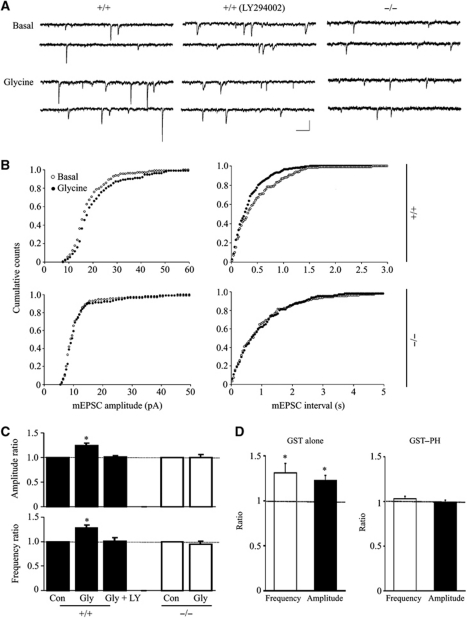Figure 6.
Glycine-induced LTP induction is impaired in PIKE−/− hippocampal neurons. (A) Representative recordings from individual cultured neurons immediately before (Basal) and 20 min after glycine (200 μM) application. Middle traces were recorded from cultured hippocampal neurons that were treated with 10 μM LY294002 for 30 min prior to the application of glycine. Scale bars are 20 pA and 200 ms. (B) Cumulative distributions of mEPSC amplitudes and interevent intervals before (○) and 20 min after glycine (•). (C) Summary of data in (A, B). Responses obtained 20 min after glycine (Gly) treatment or LY294002 pretreatment (Ly) were normalized to the values from the initial 3 min (Con) of recording. Application of glycine in the bath solution induces LTP of mEPSC (1.24±0.05 and 1.28±0.06 for amplitude and frequency, respectively; n=8). Glycine produced LTP, which is prevented by inhibition of PI3K with LY294002 (1.01±0.03 and 1. 0±0.08 for amplitude and frequency, respectively; n=5) or in PIKE−/− cultured hippocampal neurons (0.99±0.06 and 0.95±0.06 for amplitude and frequency, respectively; n=6). Data were normalized by values before glycine application (*P<0.05, Student's t-test). (D) Inhibition of glycine-enhanced mEPSCs by PIKE-L PH domain. Neurons were recorded with pipette filled with solution containing 5 μg/ml GST (1.22±0.06 and 1.31±0.11 for amplitude and frequency, respectively; n=6) or GST-tagged PIKE-L PH domain (GST–PH; 1.03±0.03 and 0.99±0.02 for amplitude and frequency, respectively; n=5). Data were normalized by values before glycine application (*P<0.05, Student's t-test).

